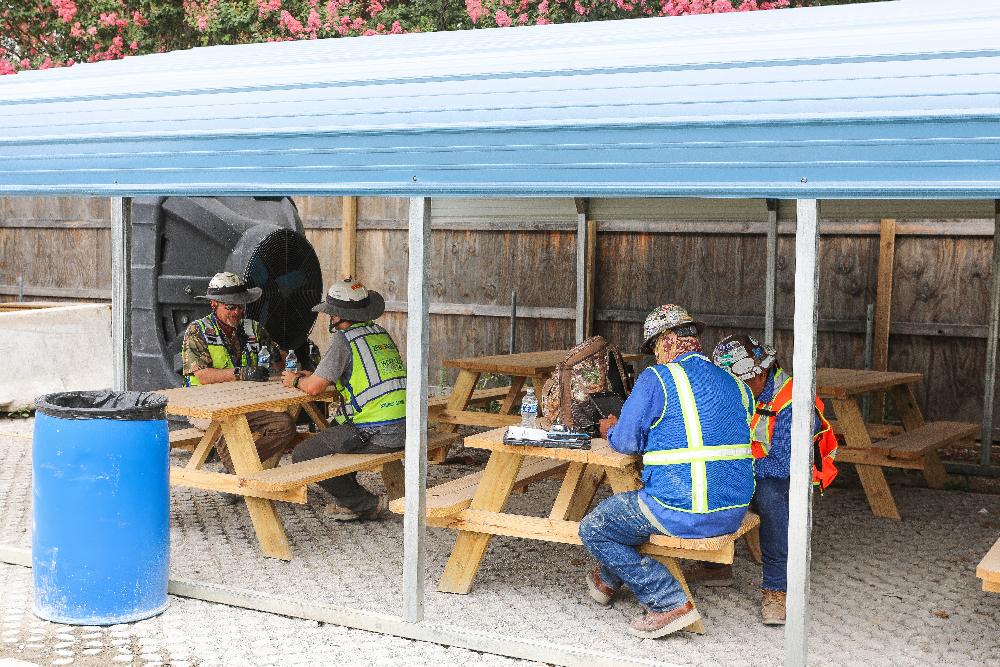
Safety reminders to ‘keep your cool’ this summer
By Richard Ryan
“Hottest summer on record” is a phrase many of us are likely tired of hearing, and none so much as construction project leaders. When you coordinate and lead hundreds of people working outdoors every day, “hottest summer” goes beyond an uncomfortable inconvenience and can quickly verge on danger for all involved.
As with many aspects of construction safety, keeping your team safe during hot conditions rests on three equally critical pillars: knowledge, preparation and collective care. When we know the warning signs, prepare to respond competently and commit to protect each other, we can reduce all incidents of heat illness.
Knowledge: know the warning signs
Getting down to the mechanics, two of the most common forms of heat illness are heat exhaustion and heat stroke. The two are often confused with each other, or misunderstood as progressive stages of the same medical event, but they are, in fact, separate conditions. Knowing the distinction (and variation of response) can be the difference between life and death.
Heat exhaustion, according to the National Institute for Occupational Health and Safety, is essentially a heat-induced form of dehydration — the body’s loss of water and electrolytes through sweat.
Heat exhaustion symptoms include:
- Headache
- Nausea and/or vomiting
- Dizziness
- Weakness
- Irritability
- Thirst
- Heavy sweating
- Elevated body temperature
- Decreased urine production
Heat exhaustion is not considered a medical emergency under NIOSH or OSHA standards. Though unpleasant, most affected workers recover within minutes given proper rehydration, cooling methods and rest.
Heat stroke, on the other hand, constitutes a true medical emergency. Onset can come without warning, so watching closely for the warning signs can save a worker’s life.
- Confusion, altered mental state or personality, slurred speech
- Loss of consciousness
- Hot, dry skin or profuse sweating
- Seizures
- Very high body temperature
In a heat stroke event, contact emergency medical services immediately. In the meantime, take quick actions to cool the worker’s body as rapidly as possible, including ice baths, soaking clothing in cool water, cold compresses and moving to shaded or air-conditioned areas.
Preparation: an ounce of prevention
The best way to reduce the impact of heat illness on construction teams is to prevent its occurrence in the first place.
Heat mitigation measures on jobsites can take many forms depending on the unique needs of your teams, the constraints of physical working spaces and the severity of heat being dealt with. On Balfour Beatty projects, we’ve experienced great success with plentiful and accessible supplies of drinking water, work rotations and designated areas for workers to rest and cool off when off-rotation. Cooling areas can also use evaporative air coolers, which come in a variety of sizes to suit even small working spaces.
In addition to water at cooling stations and throughout the jobsite, additional solutions like frozen popsicles can provide a dual benefit of body cooling and replenishing fluids. Many purpose-made popsicles even include electrolytes to facilitate complete rehydration, and again, keeping hydration up and core temperatures down is the best way to prevent most major heat illness.
Collective care: a zero-harm culture
To create a culture of mutual care (known as Zero Harm at Balfour Beatty), project leaders and supervisors must be the most informed and engaged in matters of heat safety, constantly reinforcing the importance of early warning signs and exhorting workers and trade partners to remain vigilant.
When we lead by example, we set a standard for behavior on our projects. We demonstrate to everyone involved that caring for the well-being of the person next to you is not the fulfillment of a requirement, but the fullest expression of our identity. At the end of the day, you want someone looking out for you with the same diligence and care. The victim of heat illness may not recognize their own warning signs until it’s too late, but their neighbor might, and every extra minute of response time improves outcomes significantly.
As construction professionals and project leaders, we commit to both setting and demonstrating the standard of a caring culture so we can all return home safely at the end of the day.
Remember that these warning signs and tips are just as applicable outside of the workplace as they are on your projects. As we enter summer, so too do we enter the season of near-constant warm weather and a wealth of rewarding outdoor activities. Whether mowing the lawn, coaching summer sports or playing at the pool, keep heat safety, hydration and first aid measures at the forefront of your mind. Your keen awareness and safety preparedness could prevent heat illness, or worse, in your friends and family.
Richard Ryan is Balfour Beatty US senior vice president, national safety.


 Join our thriving community of 70,000+ superintendents and trade professionals on LinkedIn!
Join our thriving community of 70,000+ superintendents and trade professionals on LinkedIn! Search our job board for your next opportunity, or post an opening within your company.
Search our job board for your next opportunity, or post an opening within your company. Subscribe to our monthly
Construction Superintendent eNewsletter and stay current.
Subscribe to our monthly
Construction Superintendent eNewsletter and stay current.